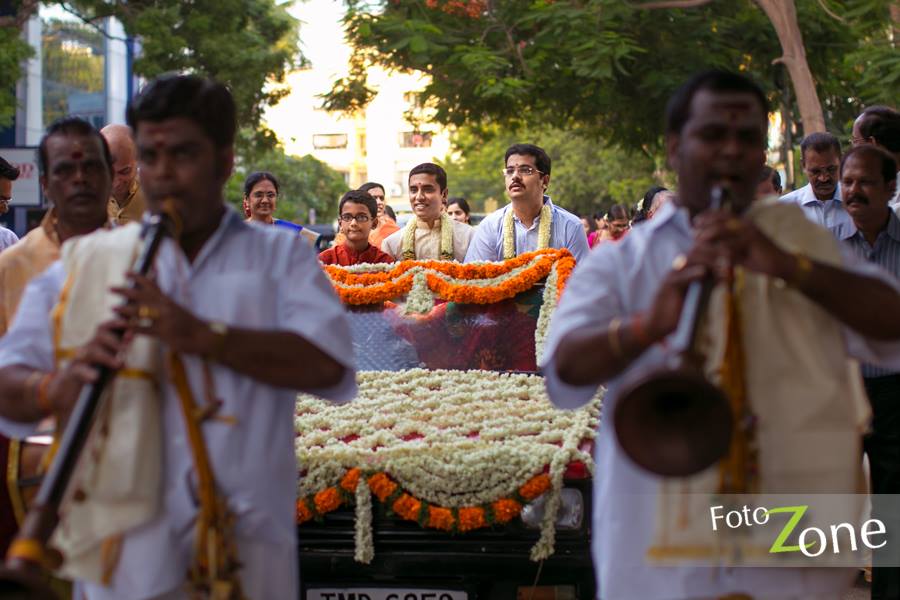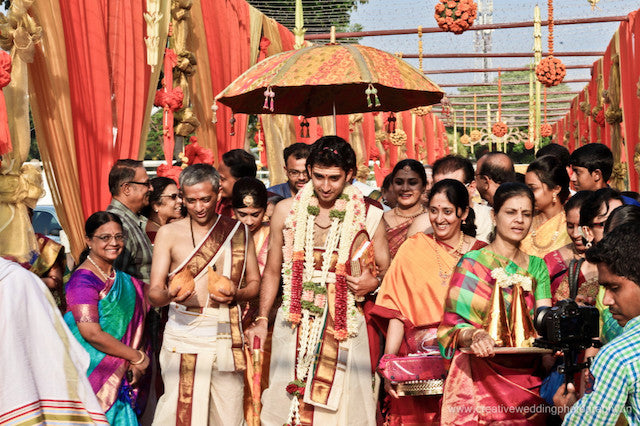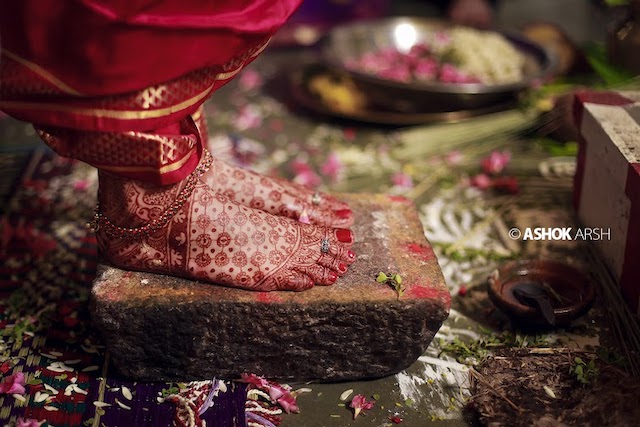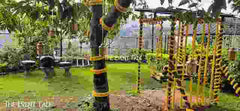
The Tam-Brahm Wedding Diary!
We are just starting a series of posts on different types of weddings and its rituals. What better way to begin than a tam-brahm wedding which has all the ingredients of emotions, fun and culture. The first thing you will notice in a tam-brahm wedding is the music. Hardly any wedding procession happens without the a typical 'Mela thalam' or the group of classical musicians in the corner who semi-conduct the entire event. The Mandapam or the wedding hall is teeming with children and aunties and young girls in their best pattu (silk) most of which have been bought/sent from Kancheepuram. The flash of gold is almost always real gold as Brahmins prefer in wearing real gold to weddings and occasions over the heavily-encrusted artificial jewellery. From ear-rings to bangles to necklaces, there are endless fashion trends you can spot at a Tam-Brahm wedding. Of course, the malli-poo (jasmin) that tied to their tresses is what completes the picture! 
While the crowd mills and the 'mamas' and 'athais' and 'athimbers' busily engage in banter while fanning themselves despite the wedding pyre being all the way in the front, the bride and the groom are pushed and prodded through various levels of grooming. The Mappillai or the groom is usually tucked into a pattu veshti called 'Panchakatcham' and left at that. He gets no shirt, only a silk shawl, while the girl is dolled up in layers of the heavy-and pricey silk Saree or Madisar. She also wears a waist oranament called ''odiyanam' and forehead ornament 'nethi chutti' along with the river of gold bangles, chains and necklaces. 
The Viradham, is when the wedding rituals begin with offerings to the forefathers and gods, all mandated by a priest. Grains are showered on the bride and groom for prosperity and blessing followed by tying of a holy yellow thread on their wrists. The marriage or 'Thirumanam' goes on for 2 to 3 days with the 'Mappillai Azhaipu' or the 'Groom's welcome' which happens on the evening before the wedding day. The marriage itself go on for a few hours as both Iyer and Iyengar customs - intricate and many in number, begin at dawn and wind up by morning. The early dawn is the most auspicious hour called the 'Suba Muhurtham' for beginning anything new. And a marriage fits right into it. 
The Kaasi-yatrai is one of the more intriguing and entertaining procession of the day. The groom shortly before the wedding ceremony itself decided he would go to Kaasi, which is a metaphor for abstaining from connubial life and into a religious path. He grabs an umbrella, a walking stick and walks away from the Mandapam
. 
The bride's father is put to the task of stalking his son-in-law down and convince him to marry the daughter. The story usually ends with the grooms enjoying being cajoled by their fathers-in-law and come back to their brides 'convinced'. 
The exchange of garlands then take place, with much laughter and chaos. The bride and groom are lifted off the ground by their family and friends, the groom by his and the bride by hers. Both sides compete in raising them higher, not letting the other aim the garland around a neck. It's a bit like the ring-throwing and prize grabbing carnival game, except this is grand-scale and the prize here is only a bride/groom. 
Soon after the Kasi Yaatra and the exchange of garlands, the to-be wed couple is seated on a swing (Oonjal in Tamil). The swing that is decorated with flowers and ornaments is made to rock back and forth. Married women stand around the oonjal and sing songs, the most popular of them being the kannoonjal song. 
Soon after this, five or seven married women clean the couple's feet with milk and then a ball of red and yellow rice is used to cast off the evil eyes. It is believed that the chain in the swing represents the karmic link of humankind with god.  After the many Kodak moments this has successfully inspired the procession moves towards the big moment, the 'Kannika Dhaanam'. It literally means 'giving away of the young girl'. While the father pours out a libation of sacred water symbolizing the giving away of the daughter to the bridegroom, the bride accepts her change of status from an unmarried woman to a wife through this ritual.
After the many Kodak moments this has successfully inspired the procession moves towards the big moment, the 'Kannika Dhaanam'. It literally means 'giving away of the young girl'. While the father pours out a libation of sacred water symbolizing the giving away of the daughter to the bridegroom, the bride accepts her change of status from an unmarried woman to a wife through this ritual.

This, is the moment where the groom ties the 'Thaali' or the sacred thread around the neck of the bride who is seated on her father's lap. This is the moment when all the photographers are snapping away hundreds of pictures in a heartbeat, the instruments reach a crescendo and the people are shower the new proud husband and coy, glowing wife with the 'Atchadhai' as a good luck blessing into their new lives. 
After the auspicious thaali is tied, the newly wed couple take seven steps around the holy fire, that is called Saptapadi (Seven steps). The couple take seven steps symbolizing the seven vows or promises they will adhere to. Later, holding on to the bride's right toe, the bridegroom helps her tread on the ammi (grindstone, in tamil). The hymns for this section state: 'Mount up this stone. Let your mind be rock firm, unperturbed by the trails and tribulations of life. At this point, the groom slips a toe ring (metti in tamil) on both her feet. This ritual is said to have multiple significances. One being that touching the bride's feet, brings humility to the groom. The other significance of the metti is that it is the only visible jewelry indicating her marital status (Her thali is usually hidden behind her clothing).

The wedding spread is usually not as elaborate as the reception and party dinners that follow with much Band-Baaja-Baaraat gusto. But the breakfast never disappoints. Scintillating idly-chutney, Sambar and Pongal that melt in your mouth washed down with a kaapi, is just perfection and speaks to every soul who has been up since 5 am. While the gift-giving and congratulating the newly wedded goes on for an hour or two, the music dips down to a more mellow Carnatic pitch. After the hustle bustle of the wedding, it is time for the couple & family to relax as well bond. The couple and the families gather to play a list of games like the bride marking the groom's feet with color paste; fanning him, showing him a mirror; breaking papads (thin, roasted lentil flour crisps) over each other's head; wrenching the betel pack from each other's hand; rolling the coconut from one to another as in ball-play; and so on. During these games, the ladies sing songs poking fun at the bride, groom and the in-laws. All the family members are in a relaxed state of mind knowing that the wedding is finally over. 
For they have witnessed the typical tam-brahm wedding in its elements, swathed in the silken folds of its culture, the older majority reminiscently dabbing at the corners of eye and pronouncing to any young teenage girl in sight "You must be next!" A typical, honest to goodness Tam-Brahm wedding would be incomplete without all of it.



